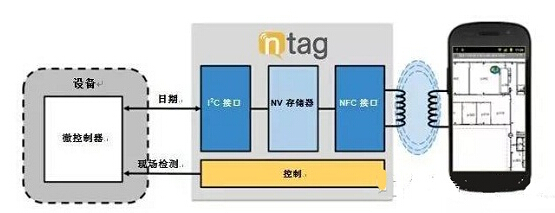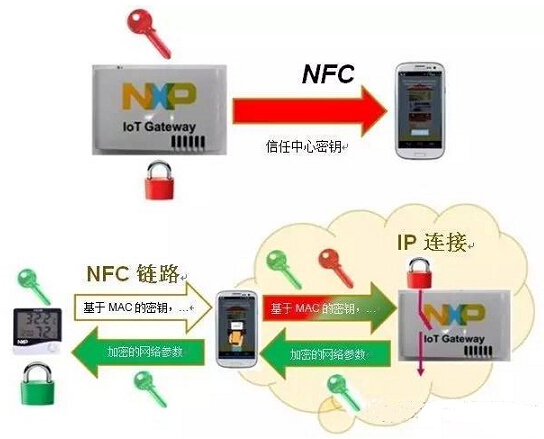ZigBee home automation system uses NFC technology to add device security to the network
Use NFC to add devices to the network (NFC commissioning)
The operating frequency of the NFC wireless standard is 13.56 MHz, and the wireless data rate is 106 kbps. It provides a way to transfer data from a powered device (such as a mobile phone) to a non-powered, disconnected device (such as a light switch) over a short distance (a few centimeters). The power of the NFC signal from a powered device will be used to provide the very low power needed to power on the NFC receiver and memory in the non-powered device, allowing the information to be transferred to the local memory of any type of product. This technique is particularly suitable for devices such as light bulbs prior to installation, and also for energy-saving light switches, which do not require more energy than transmitting several data packets. NFC has a short transmission distance, which ensures full protection against third-party access to network keys. The operation of transferring data is also very simple, just put the smartphone close to the device and start the application that transfers the data. There are several options for using NFC to transmit security credentials.
The simplest option is to use completely passive NFC tags that can be programmed to have unique keys for joining the network. During the manufacturing process, we provide a single-chip ZigBee device with a unique key for exchanging the information needed to join the network. During the manufacturing process, this unique key is copied to the tag along with the MAC address. The tag is pasted on or embedded in the final product. The simplest tag may be a single sticker containing the NFC chip and the desired coil antenna. Alternatively, the chip and antenna can be integrated into the structure of the device itself. End users can read this unique key using the built-in NFC reader in the mobile phone. The mobile phone is connected to the gateway of the ZigBee network via WiFi, so the key can be transmitted securely.
The ZigBee Coordinator then uses this key to encrypt the network key and then the network key can be sent to the MAC address of the new device. Once the new device has obtained the network key, it can safely join the ZigBee network. This method provides a secure technology for adding devices to the network, but its functionality is limited, and then it requires a lot of interaction to set up the ZigBee device and add it to groups and scenarios. It also creates production difficulties because each tag needs to match a specific ZigBee device address to provide optimal security.
The full value of NFC can only be achieved when the tag is electrically connected to a ZigBee device. The tag will effectively act as a dual port memory. One port is connected to the NFC interface and the other port is connected to the I2C port. In this case, data can be transferred from the mobile phone to the tag memory. The I2C port can then be used to transfer this information to the wireless microcontroller that manages the ZigBee network. If you need to power the microcontroller during data transmission, you can also use the NFC tag to provide a small amount of power (up to 5mA). A typical interconnect tag, such as the NXPN TAG device shown in Figure 1, can store 1 or 2 KB of data.

This feature provides many possibilities for the device to join the ZigBee network. First, it provides a simple way to securely add network keys to devices using smart phones that support NFC technology. The phone can obtain the necessary key through the protected WiFi connection with the system gateway. Or you can use the NFC transport key by contacting the phone with a gateway or remotely regulated device. When the phone is close to the device to join the network, the key can be transmitted.
As this can transfer large amounts of data, the system's functionality can be significantly enhanced. Run the app on your phone and users can see all the devices that have joined the network. In this way, they can set the control relationship on the mobile phone while installing the network key, and program this relationship on the mobile phone. In addition, you can add a textual name to your device to easily identify the device, perhaps associating it with a photo of your location. All of the above methods can be implemented using an interconnected NFC tag. There is no doubt that many new technologies will be available using the features provided by this technology.
Residential control system
To demonstrate the way ZigBee networks work by adding devices to the network via NFC, we designed and built a residential control demo system (Figure 2). The system is based on an intelligent thermostat that monitors temperature and humidity and uses the ZigBee home network automation profile running on the JN5168 wireless microcontroller and the NFC technology implemented on the NTAG interconnect tag to connect. We wrote a smartphone application to add devices to the network and assign control relationships. Each room is equipped with a separate plexiglass box, equipped with heater elements and a thermostat, and connected via the ZigBee home automation system. Lights and smart sockets can be added separately to the system.

In this example, the network coordinator is a gateway device that runs the Open WRT Linux operating system. The gateway is also equipped with an NFC reader device. In this way, the only security key provided by the gateway can be received by simply bringing the mobile phone close to the gateway. Then move the phone closer to the device. The phone receives the unique network join key from the device. The key is then transmitted back to the gateway and encrypted using a unique gateway key.
The gateway then sends the network parameters to the device, encrypting it with a device unique key that no one else knows about. In this way, network security credentials are not sent through any mechanism without encryption. Once the device has network parameters, it can safely join the network. The same program can be used for other devices in the system, such as lights, smart sockets, switches, and the like. Figure 3 illustrates this process graphically.

summary
As people's demand for home automation functions increases, they more urgently need safe systems. ZigBee home automation is a powerful and stable open standard that can meet the connection and application needs of home automation. However, we can use the out-of-band technology to transmit network credentials, and standard methods for adding devices to the network and for key exchange are enhanced. Using an NFC tag connected to a ZigBee device, secure information transmission can be achieved without being detected by malicious network traffic listeners. The rapid development of home climate control systems using ZigBee home automation and NFC-based network access methods has proven this.
With an experience of over 30 years, Helper has designed and manufactured full series of pasta and Vegetable Processing Machines, like bakery industrial dough mixer, automatic fresh and cooked Noodle Production Line, vegetable cutting machine, Slicer And Dicer , automatic dumpling machine/Dumpling Machines, sesame mill, pancake forming machine etc. A pasta branch company was estblished with the development the business, owning a group of talented technical people, skilled production workers, and a professional sales and after sales service team. Many famous companies such as Dali Group, Panpan Group, Wanchai Ferry, Sinian Group, and so on have chose Helper as their strategic supplier and partner.
Pastry And Vegetable Processing Machines
Pastry Processing Machines,Food Packaging Machines,Vegetable Processing Machines,Noodle Production Line,Dumpling Machines
Shijiazhuang Helper Food Machinery Co., Ltd. , https://www.processings.nl